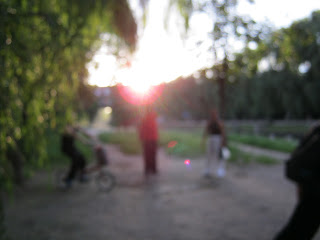Today was especially noteworthy, and I know you’re all
thinking it’s because I went to one of the top tourist attractions
of Beijing, but I must tell you it is not.
Instead, I was able to go able to go and practice Baguazhang (八卦掌;Eight Trigram Palm), an
internal style of Chinese martial arts. Baguazhang,
although an internal style like Tai Chi, is based around walking in a circle,
which is often personified by the yin yang symbol surrounded by eight trigrams
from the I-Ching (易经;Yi Jing), or Book of
Changes, in an octagon. The eight
trigrams in the symbol each have their own significance in regards to the
cardinal directions, the body, times of day and the zodiac, and are taken from
the 64 hexagrams (shown below) in the Yi Jing.
Above: the Eight Trigrams (Bagua)
As this was my first time using the Beijing Subway to get somewhere, it
was a rather interesting and long journey.
I had to transfer trains twice, which wasn’t that complicated thanks to
signs in Chinese and English that showed how to transfer. My destination was Xizhimen Station (西直门站;Shi Zhir Men Zhan), slightly
Northwest of the center of the city and close to the Beijing Zoo and Beijing
North Railway Station (in fact, the railway station can be accessed right after
one exits the subway). From the station I
walked a bit and eventually ran into the American I had contacted about Bagua,
who then led me across a foot bridge to an island park where I was able to meet
his Shifu, Sui Yunjiang, before taking a bit to stretch out and warm up before
class began. During class, my American
acquaintance, Keoni, explained to me that Master Sui not only taught Baguazhang
but another style called Meihuazhuang (梅花桩;Plum Flower Pillars), which, after seeing a bit of it, seemed somewhat
like Long Fist and Bagua combined, but with slightly different movements. While I wanted to get some pictures of the
Meihuazhuang students practicing, it was difficult to catch a shot. The course began with some Contemporary
Wushu-like exercises such as crescent moon kicks, sidekicks, and other kicks
before moving into combinations of these with sweeps, hits and jumps before
moving onto butterfly kicks and 50 jumping inward and outward crescent moon
kicks. Following this, we stretched out
again and then I was able to begin some training in Bagua. I trained with Keoni in his “circle”, which
was a piece of ground that had been walked on so much that it had itself become
a circle, the only one that was deeper was Shifu Sui’s Circle (see below),
which was
unfortunately covered in water from the rain earlier that day. That day I went over the basic stepping
movement and direction changes of Bagua, while Keoni explained to me that the
style they practiced Liang Baguazhang, was different than the style I had
practiced in Arizona, Sun Baguazhang (from what I can remember, as I had only
jumped on my interest in seriously training in Bagua this past year), in that
there were no forms based on the 8 Animals of Bagua, but the animal forms
sometimes showed up in the various forms within the Liang system. So, until around 6 PM that night I practiced
basic stepping and direction changes, as well as the positioning of the feet,
lowering the qi into the Dantian and just making sure to get the little things
right, all the while paying attention to the sun setting on the old Beijing
Exhibition Center across the canal and the people walking past, watching and
listening.





No comments:
Post a Comment